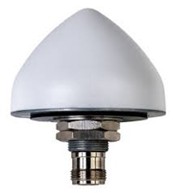Signal integrity is the backbone of modern communication and navigation systems. In fields like defense, transportation, and logistics, even brief interruptions or inaccuracies can disrupt operations, compromise safety, or lead to costly delays. Standard antennas can handle basic signal reception but are vulnerable to interference from natural sources such as solar storms or atmospheric conditions, as well as intentional threats like signal jamming.
Anti-jamming antennas are designed to address these challenges. They can detect and reduce interference in real time, maintaining reliable performance even in demanding or contested environments. This level of resilience ensures that critical communications and navigation systems remain accurate, secure, and operational when it is needed most.
What’s the Difference Between Standard and Anti-Jam Antennas?

Standard antennas are widely used in everyday applications and perform well under normal conditions but can be affected by environmental interference, signal congestion, or other sources of disruption, which may lead to reduced accuracy or occasional signal loss.
An anti-jamming antenna, on the other hand, is specifically designed to maintain reliable signal reception even in challenging or hostile environments. It uses advanced technologies such as adaptive filtering, directional reception, and signal processing algorithms to detect and reduce interference. This allows the antenna to block or mitigate the effects of intentional jamming, electronic noise, and environmental disruptions. Anti-jamming antennas are commonly used in defense, critical infrastructure, and high-precision navigation systems where consistent performance and security are essential.
Why Anti-Jamming Antennas over Standard?

Anti-jamming antennas provide a clear advantage over standard antennas because they are designed to maintain reliable signal reception even in environments with interference or intentional disruption. GPS jamming incidents are becoming more frequent and serious worldwide. Sweden reports Russian GPS jamming over the Baltic, disrupting flights and raising security concerns. Fake signals caused flight disruptions at Delhi Airport, showing how vulnerable navigation systems can be.
Even high-profile operations are affected. An EU leader’s plane was hit by suspected Russian GPS jamming over Bulgaria, and GPS disruptions near Venezuela and Trinidad highlight the global reach of this problem. These events demonstrate how exposed navigation and communication networks can be when interference occurs.
Here are some key reasons why anti-jamming antennas are the best choice:
Enhanced Signal Reliability
Standard antennas are prone to interference from natural sources, electronics, and jamming, which can cause signal loss or dropped communications. Anti-jamming antennas detect and reduce interference, keeping signals stable even in challenging environments.
Protection Against Intentional Jamming
In defense and critical infrastructure, deliberate signal disruption is a real threat. Anti-jamming antennas use filtering, directional reception, and adaptive algorithms to maintain operations, unlike standard antennas that can be easily affected.
Improved Accuracy for Navigation and Timing
GPS and GNSS systems require precise signal reception. Anti-jamming antennas reduce noise and maintain signal clarity, ensuring accurate positioning, timing, and system performance even when interference is present.
Long-Term Cost Savings
Anti-jamming antennas may cost more upfront but reduce downtime, errors, and maintenance over time. For industries where reliability is critical, they deliver significant operational efficiency and security benefits.
Standard antennas work for everyday use, but in high-interference or precision-critical environments, anti-jamming antennas provide clear advantages. Bodet and Safran offer advanced solutions that enhance reliability, accuracy, and security, ensuring uninterrupted signal performance. If you think an anti-jamming antenna is right for you, please contact our sales team today for a free consultation and quote.





